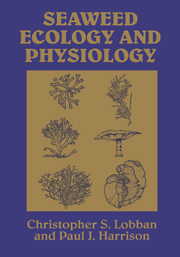Book contents
- Frontmatter
- Contents
- List of contributors
- Preface
- 1 Morphology, life histories, and morphogenesis
- 2 Seaweed communities
- 3 Biotic interactions
- 4 Light and photosynthesis
- 5 Nutrients
- 6 Temperature and salinity
- 7 Water motion
- 8 Pollution
- 9 Seaweed mariculture
- Appendix: Taxonomic classification of algae mentioned in the text
- References
- Index
7 - Water motion
Published online by Cambridge University Press: 18 December 2009
- Frontmatter
- Contents
- List of contributors
- Preface
- 1 Morphology, life histories, and morphogenesis
- 2 Seaweed communities
- 3 Biotic interactions
- 4 Light and photosynthesis
- 5 Nutrients
- 6 Temperature and salinity
- 7 Water motion
- 8 Pollution
- 9 Seaweed mariculture
- Appendix: Taxonomic classification of algae mentioned in the text
- References
- Index
Summary
The waters of the oceans are in constant motion. The causes of that motion are many, beginning with the great ocean currents, tidal currents, waves, and other forces, and ranging down to the small-scale circulation patterns caused by local density changes (Vogel 1981; Thurman 1988). Hydrodynamic force is a direct environmental factor, but water motion also affects other factors, including nutrient availability, light penetration, and temperature and salinity changes. The forces embodied in waves are difficult to comprehend, unless one has been dangerously close to them; because of the density of water, a wave or current exerts much more force than do the winds. “Imagine a human foraging for food and searching for a mate in a hurricane and you will have only an inkling of the physical constraints imposed on wave-swept life” (Patterson 1989, p. 1374). The energy amassed from a great expanse of air–ocean interactions is expended on the shoreline as waves break (Leigh et al. 1987). Equally difficult to visualize and measure are the microscopic layers of water next to plant surfaces where the plants' cells interact with water. Too much water motion imposes drag stresses on seaweeds; too little imposes diffusion stresses and impairs nutrient uptake (Wheeler 1988). Biomechanical studies of seaweed form and function are beginning to give some insight into this trade-off; see the reviews by Koehl (1984, 1986). Denny (1988) has provided a solid foundation in fluid mechanics for the study of marine organisms.
- Type
- Chapter
- Information
- Seaweed Ecology and Physiology , pp. 241 - 254Publisher: Cambridge University PressPrint publication year: 1994
- 1
- Cited by



